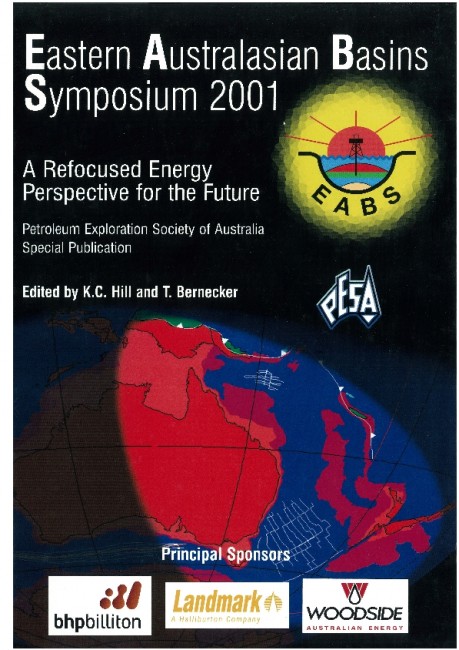Publication Name: Eastern Australian Basins Symposium 2001
Authors: J. Bruins, I.M. Longley, J.P. Fitzpatrick, S.J. King and R.M. Somerville
Date Published: November 2001
Number of Pages: 27
Reference Type: Magazine Article
Abstract:
The Ceduna Sub-basin comprises one of the major untested potential petroleum provinces in Australia. It is located in the Great Australian Bight with water depths ranging from 100 metres in the north to over 4,000 metres in the south (Figure 1). The basin is unique in Australia since it contains a very thick late Cretaceous deltaic sequence overlying a narrow early-middle Cretaceous marine rift basin. Similar deltaic basins elsewhere in the world have proven to be highly productive hydrocarbon provinces.Hydrocarbon exploration in the area is at an immature stage. The sole exploration well within the Ceduna Sub-basm lS Potoroo-1 drilled by Shell in 1975. It is located on the extreme landward flank of the depocentre. Subsequent to Shell 's work, new seismic acquired indicates that Potoroo may not have tested a valid trap. Outside the Ceduna Sub-basin, the closest control wells are Jerboa-1 drilled in the Eyre Sub-basin by Esso in 1980
and Apollo-1 drilled in the Denman Basin by Outback in 1975. These wells are situated more than 180 km away from the mam Ceduna kitchen area. Thus the Ceduna basin is believed to be totally untested by exploration drilling.
Until recently, the seismic coverage over the Ceduna Sub-Basin was sparse with up to 20 vintages of disparate data giving an average data density varying from 30 x 20 km in the south to 6 x 3 km in the northeast (Figure 2). The most recent seismic acquisition and processing in the area, prior to the spec data acquired for the 2000 gazettal round, was in 1982. In July 2000, three blocks EPP28, EPP29 and EPP30 spanning the entire Ceduna depocentre were awarded to a cons01tium comprising Woodside Energy Ltd, Anadarko Petroleum Corporation and PanCanadian Energy Corporation.
In December 2000 Woodside Energy Ltd, on behalf of the Joint Venture partners, embarked on the Flinders 2D Survey, acquiring a total of 15,636 km of full fold seismic data across the three exploration permits (Figure 3). The survey was acquired in just under five months by the MV Geco Angler, a Western-Geco vessel, and was completed without a major HSE incident. The line density ranges from 4 x 4 km in the west and 4 x 8 km in the northern and eastern portions of the survey. In order to ensure that any potential AvO effects were captured, especially in the
deeper prospects, the streamer length was set at 6 km with data being recorded to nine seconds.
Processing of the newly acquired seismic data was canied out by Western-Geco's processing centre in Perth, and by the beginning of September 2001 all full offset migrated stacks were delivered. The main challenges for data processing were theremoval of swell noise, the attenuation of a strong water bottom multiple, peg leg multiples and associated aliased noise, particularly in the deep water areas of the survey. With the use of modern processing techniques swell noise was effectively removed from the data and multiple energy and associated
aliased noise were significantly reduced.
Potential Field data acquired during the Flinders 2D survey has been processed and integrated with existing regional potential field data
The most promising play types are numerous large dip and fault-dip closures associated with listric faults within the very thick (up to 3.5 km) Late Cretaceous (Santonian-Maastrichtian) deltaic sequence (Figure 4). Further potential for fault-dip closures and a channel sub-crop play is recognised within the Santonian section. Rotated fault blocks in the Turonian and older sections constitute another potential play, although porosity degradation with depth might be an issue. Total umisked potential in the permits is estimated to be in the multi-billion
barrels range.
Hydrocarbon charge and phase are perceived to be the most significant exploration risks. Although asphaltite strandings have been reported, the hydrocarbon charge system is unproven and, given the dominance of terrestrial material in many of the deltaic sequences elsewhere in the world, it may be gas prone. Recent source rock investigations by AGSO have identified organic-rich rocks in Valangian to Cenomanian sequences in onshore and offshore wells.
In view of the perceived harsh oceanographic conditions in the Great Australian Bight, a 12-month Metocean Project has been statted. A Directional Wave Rider and Current Meters were deployed in Exploration Permit EPP29 on 29 May at a water depth of 1,500 m. The analysis of the results and the subsequent assessment of the metocean conditions will be used to optimise well designs and frame operating conditions.
The joint venture plans to drill at least one well in 2002 - 2003. The estimated well cost is A$35 million, which, together with the cost of seismic and other studies, will result in the venture having invested some A$45 million in this difficult, high risk, frontier area in order to test the Cretaceous play concepts.


